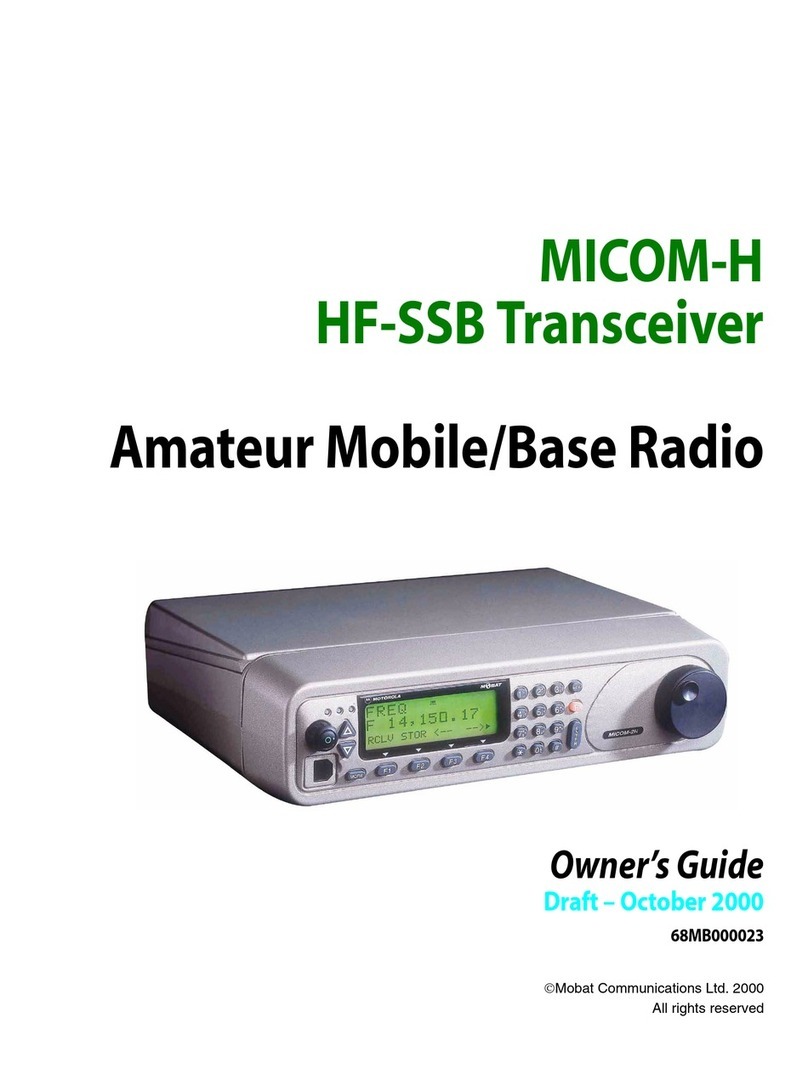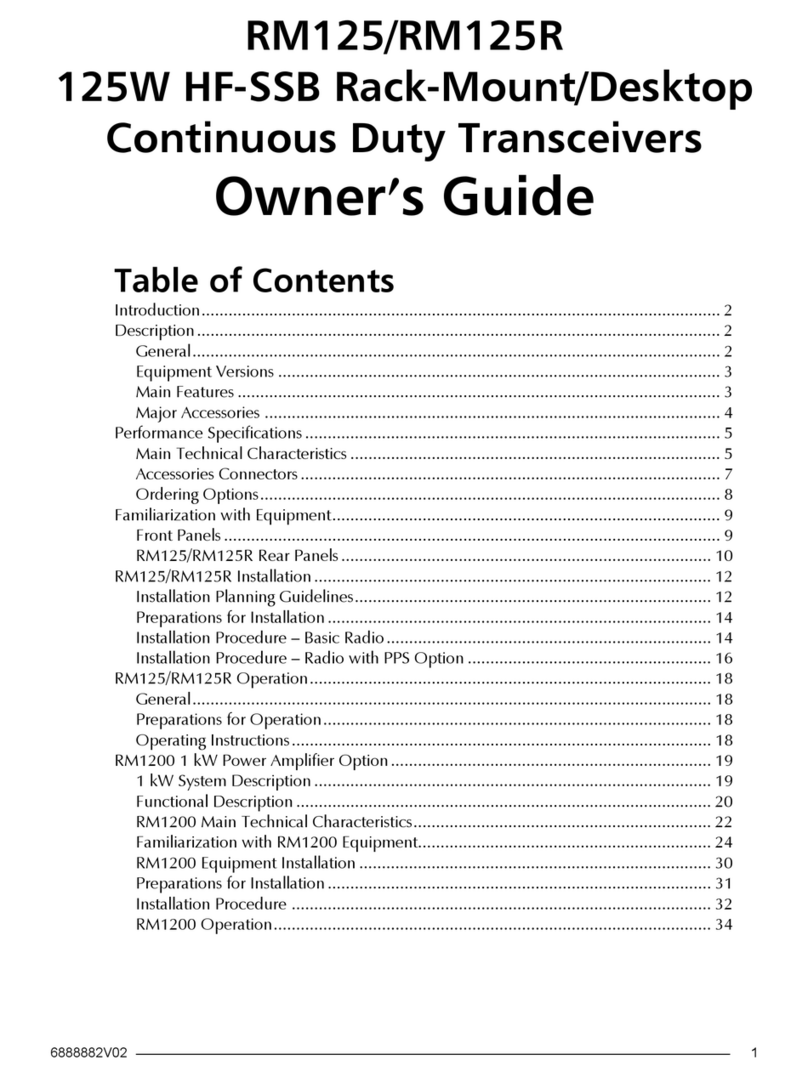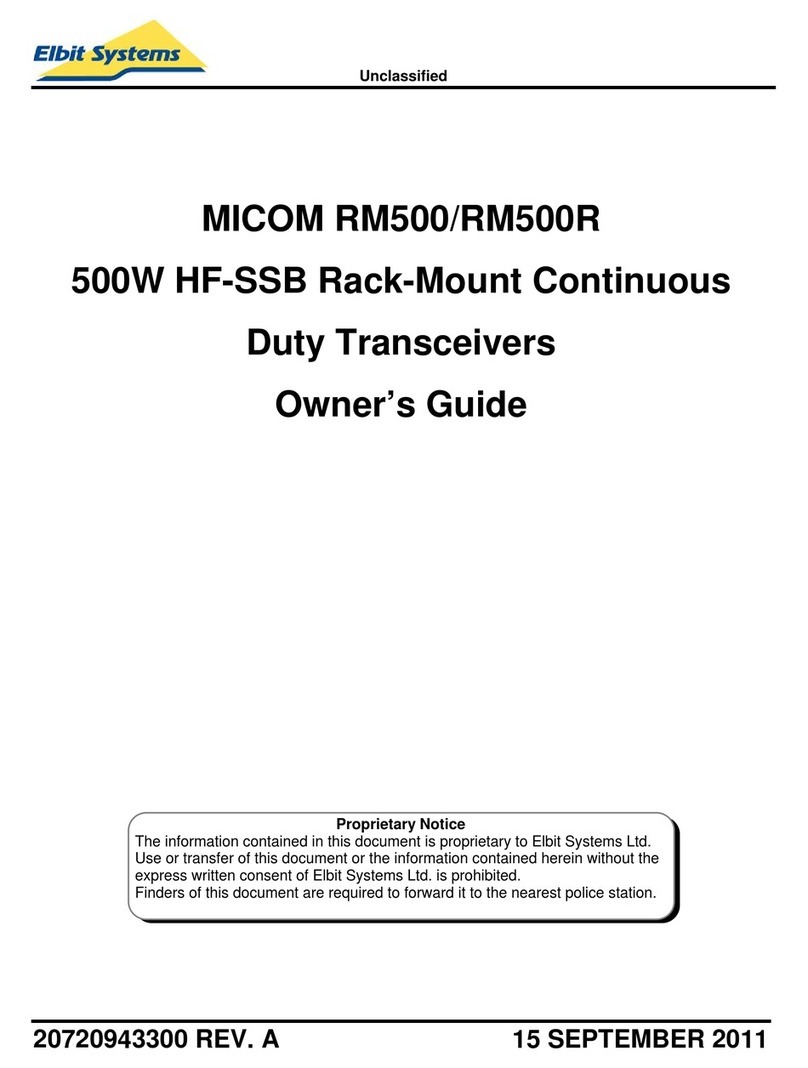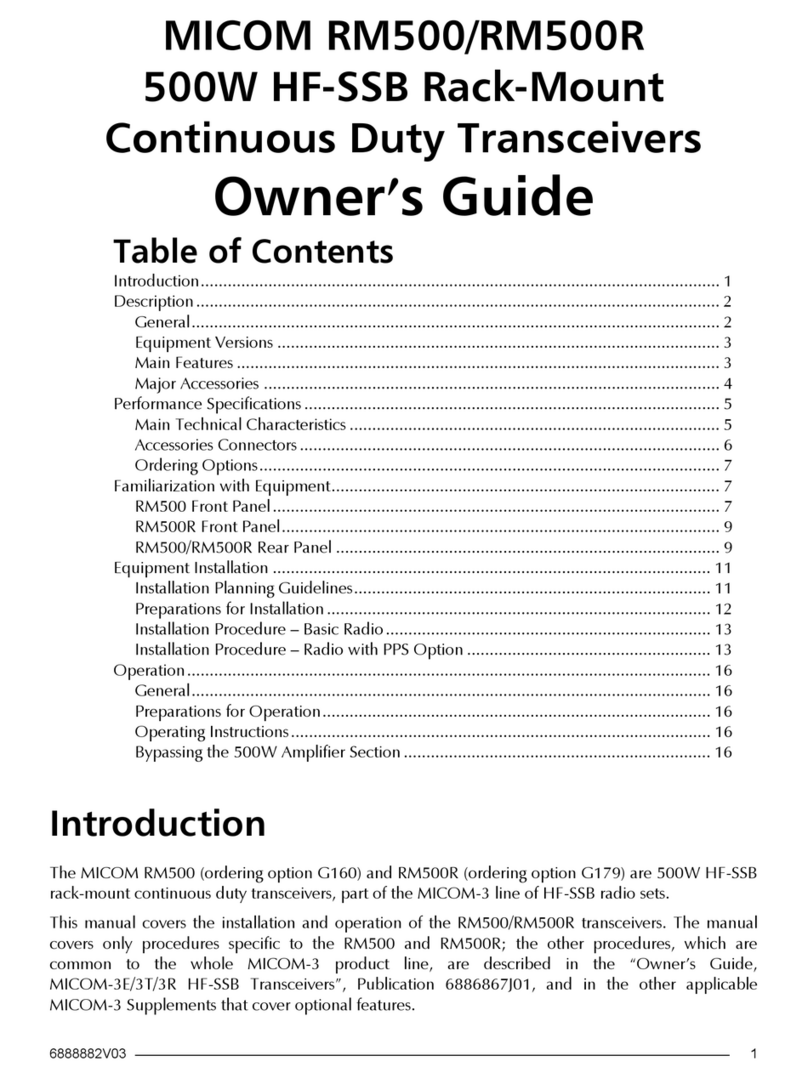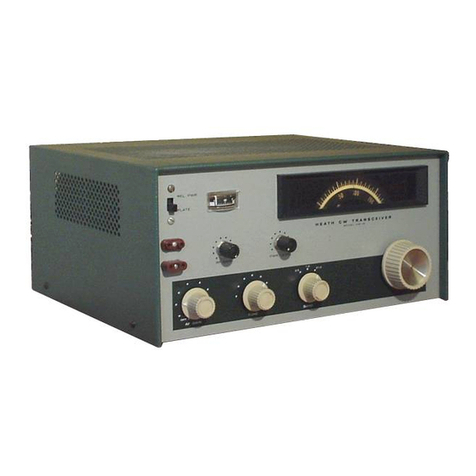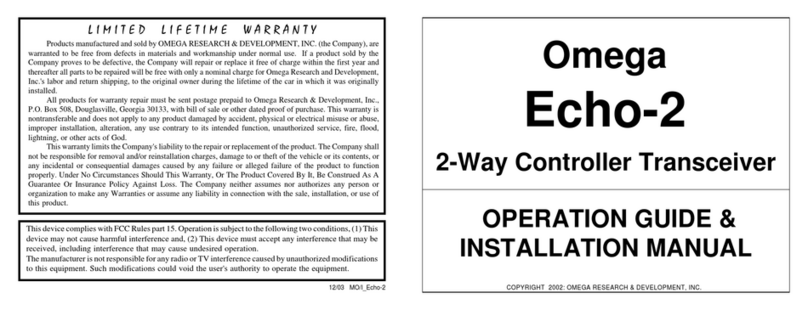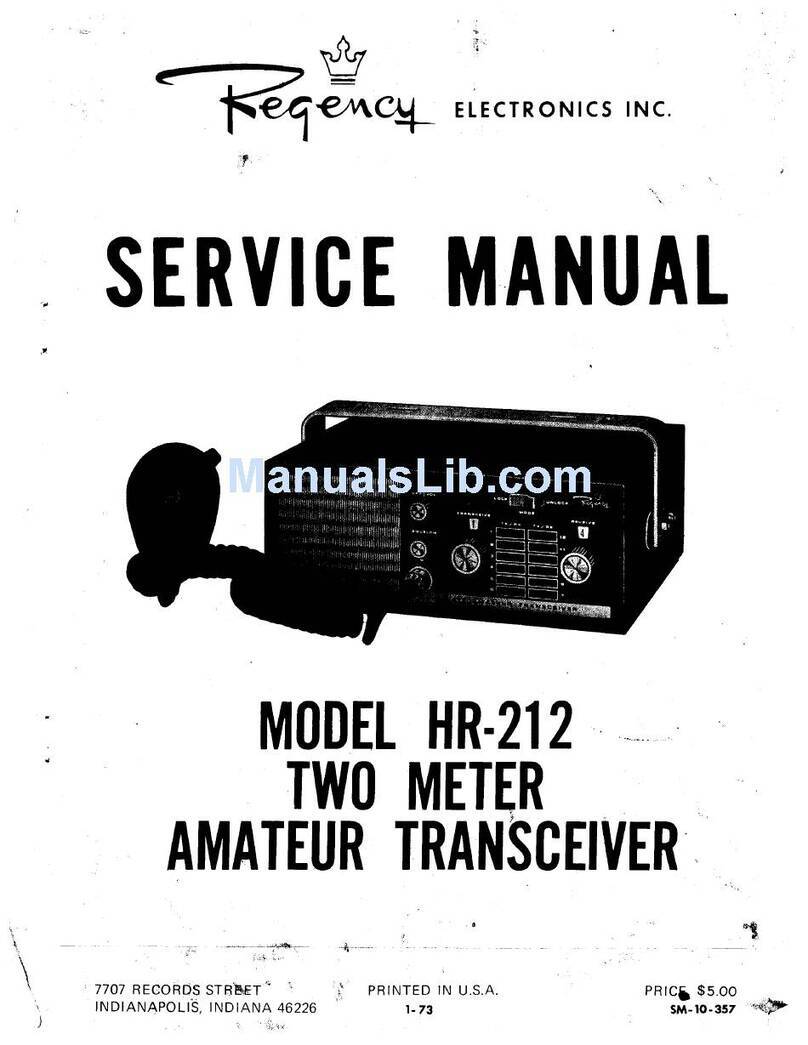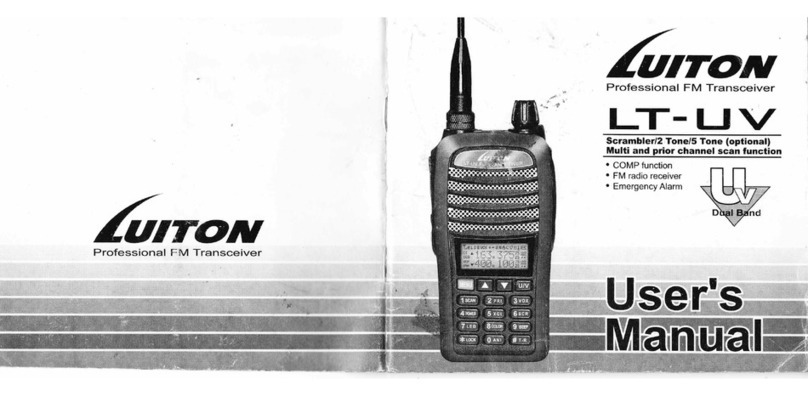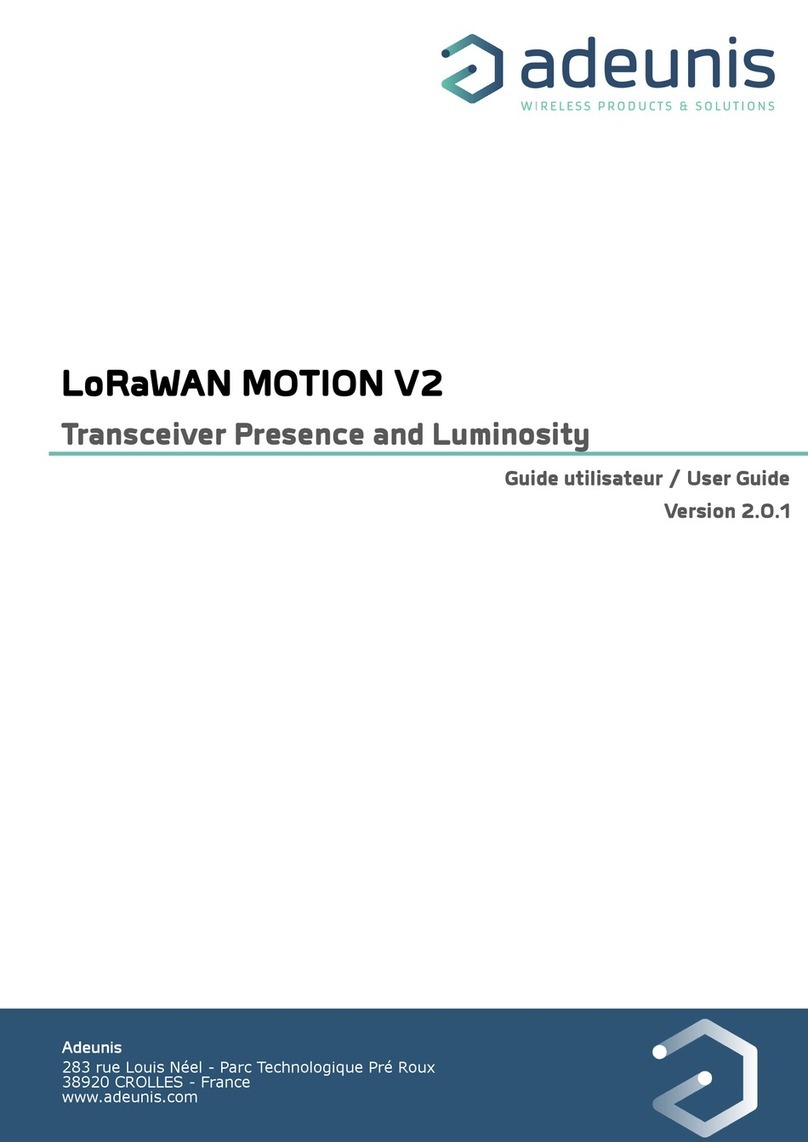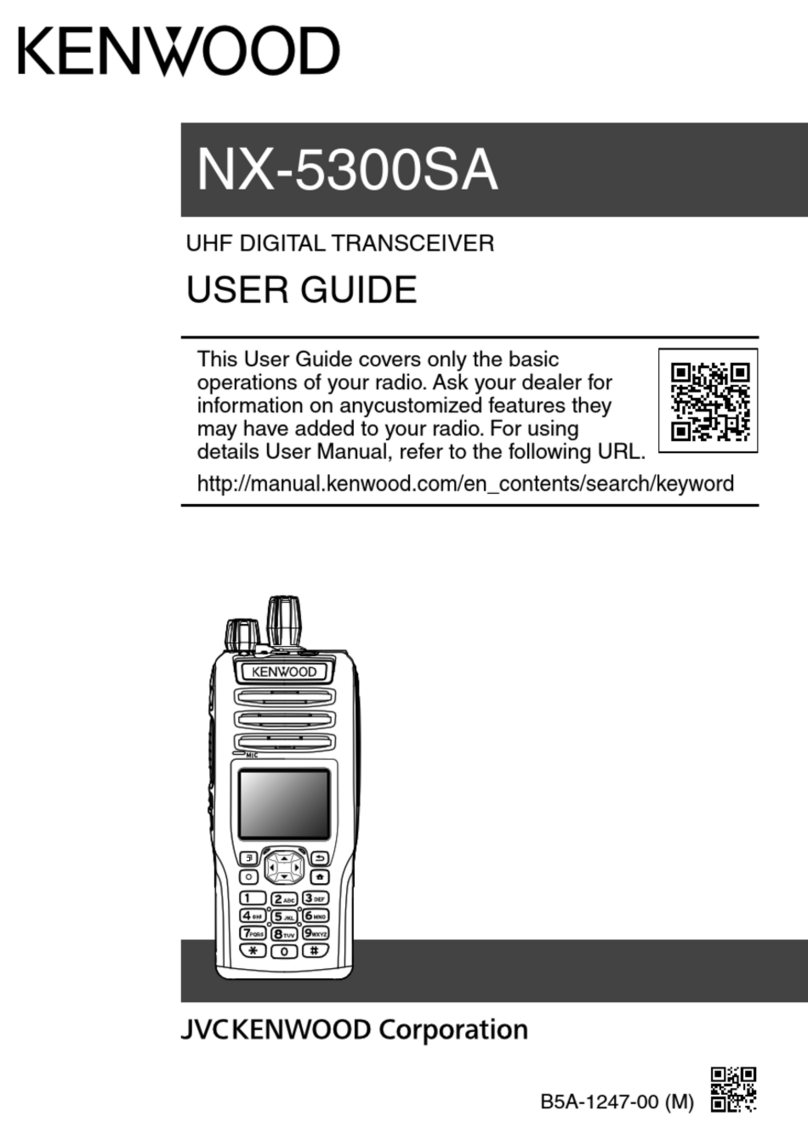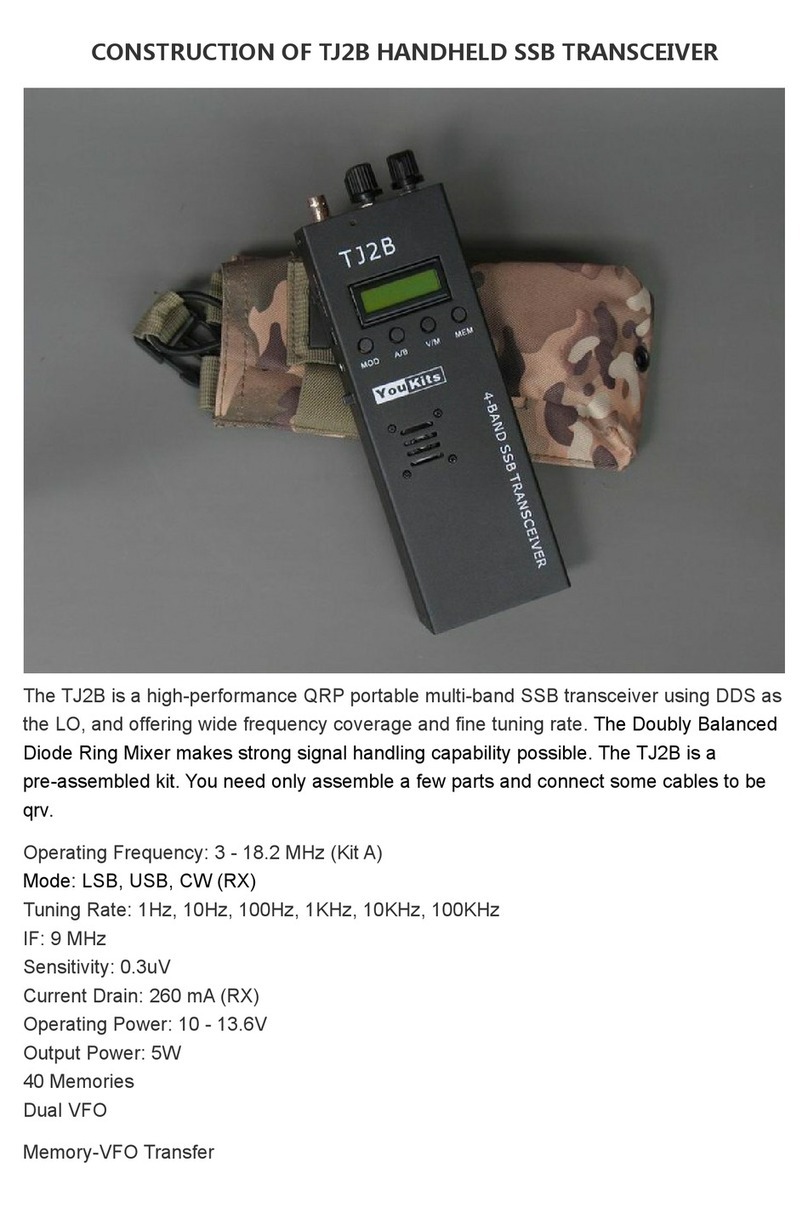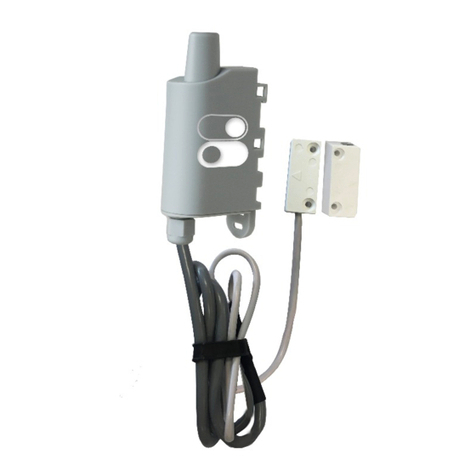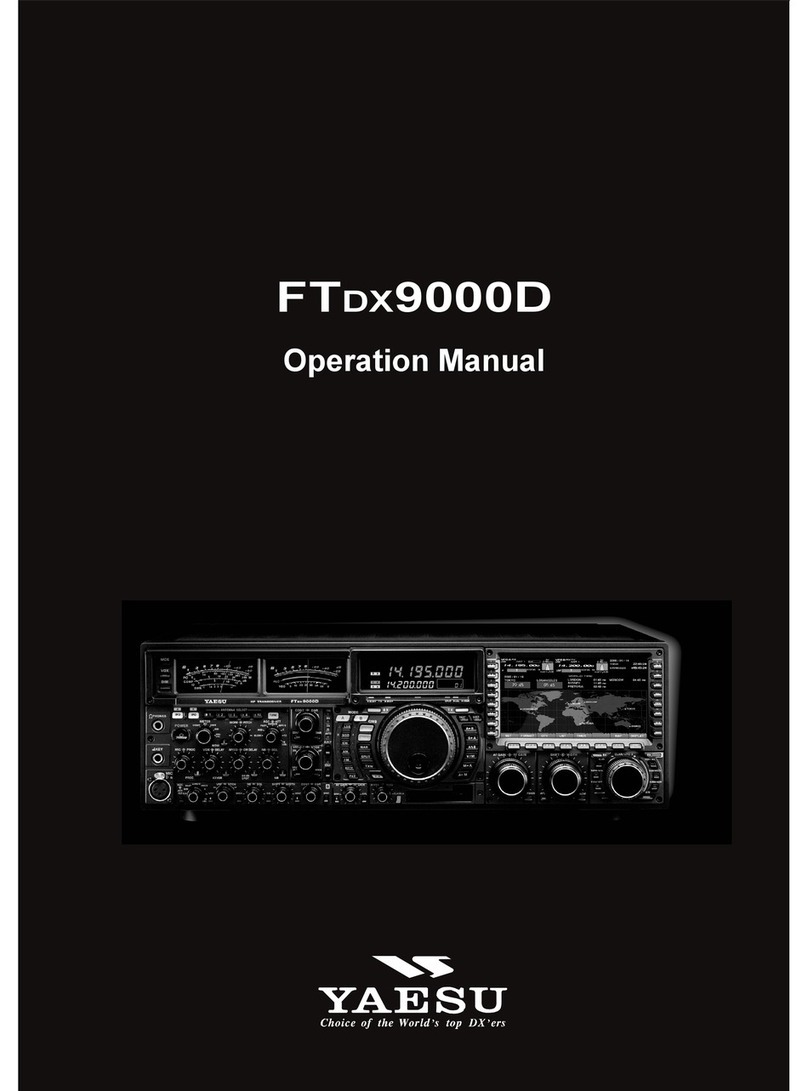Micom 3f User manual

Owner’s Guide
Part I - Operation & Installation
6886867J01A
MICOM-3F/3T/3R
HF-SSB Transceivers


MICOM-3F/3T/3R
HF-SSB Transceivers
MOBAT USA
1720 West Paul Dirac Drive
Tallahassee, 32310 FL
United States of America
Owner’s Guide
Part I – Operation & Installation
Cat. No. 6886867J01A


Table of Contents
Table of Contents
Page
Introduction .....................................................................................................................1
MICOM-3 HF-SSB Radio Features......................................................................2
MICOM-3 Options and Accessories....................................................................3
Familiarization with MICOM-3 Radios..............................................................................4
MICOM-3F Front Panel......................................................................................4
MICOM-3T Front Panel......................................................................................5
MICOM-3R Front Panel .....................................................................................6
Rear Panel (All Models) ......................................................................................7
LCD Display Functions .......................................................................................8
General Procedures............................................................................................10
Using the External (USB) Keyboard Option (MICOM-3F/3R only) .......................13
The Menu ..........................................................................................................14
Basic Operating Instructions .............................................................................................16
Turning the Radio On and Off............................................................................16
Transmitting and Receiving.................................................................................17
Using the Channel Mode....................................................................................18
Using the Frequency Mode ................................................................................22
Using the Scan Mode .........................................................................................30
Using the BIT Mode ...........................................................................................31
Locking the Radio...............................................................................................32
Changing the Password.......................................................................................33
Using Automatic Link Establishment (ALE).........................................................................34
ALE Capabilities and Features.............................................................................34
Using ALE Functions in the Channel Mode .........................................................43
Entering the ALE Mode.......................................................................................43
Receiving and Transmitting Calls in ALE Mode....................................................45
Using the Programming Mode ..........................................................................................78
Programming the Radio Parameters ..................................................................................81
Programming Channels.......................................................................................82
Selecting Radio Parameters.................................................................................84
Setting Radio Options.........................................................................................86
ALE Programming .............................................................................................................87
Programming Nets..............................................................................................88
Setting the Net Options ......................................................................................90
Directory Parameters..........................................................................................90
AMD Message Configuration ..............................................................................91
ALE Options Configuration .................................................................................91
Auto Dial Parameters..........................................................................................93
i

MICOM-3F/3T/3R HF-SSB Owner’s Guide
Storing ALE parameters.......................................................................................93
Using the New Station Address Filter ..................................................................94
Using the VP-116 Mini Voice Privacy Unit........................................................................95
Introduction .......................................................................................................95
Specific Parameters for Privacy Operation ..........................................................95
Connecting/Disconnecting the VP-116 Unit........................................................95
Using the VP-116 Unit .......................................................................................96
Programming the VP-116 Unit from the MICOM-3 ............................................97
Using the Vocoder............................................................................................................100
Introduction .......................................................................................................100
Using the Vocoder..............................................................................................100
Programming the Vocoder..................................................................................102
Using the MICOM-3 GPS Receiver ...................................................................................104
Introduction .......................................................................................................104
GPS Receiver Functions......................................................................................104
GPS Antenna......................................................................................................105
Operating the GPS Receiver ...............................................................................106
Installation........................................................................................................................110
General ..............................................................................................................110
Base Station Installation......................................................................................111
MICOM-3R Installation ......................................................................................112
MICOM-3F Installation.......................................................................................113
MICOM-3T Installation.......................................................................................113
Installation Procedures .......................................................................................115
Connectors.........................................................................................................120
Maintenance ....................................................................................................................124
Introduction .......................................................................................................124
Preventative Maintenance ..................................................................................124
Using BIT ...........................................................................................................125
Troubleshooting .................................................................................................127
Service ...............................................................................................................129
Appendix A micomTrooper 3 5-50 Watt HF-SSB Backpack Transceiver ...........................130
Introduction .......................................................................................................130
Preparing the micomTrooper 3 for Operation.....................................................134
Operating Instructions ........................................................................................140
Preparing micomTrooper 3 for Static Operation .................................................141
Using the micomTrooper 3 Battery Charger, FLN9541 .......................................142
List of Procedures .............................................................................................................144
ii

Acronyms
Acronyms
AGC Automatic Gain Control
ALE Automatic Link Establishment
AMD Automatic Message Display
AME Amplitude Modulation Equivalent
ARQ Automatic Repeat Request
BITE Built-In Test Equipment
CW Continuous Wave
DSP Digital Signal Processing
DTCXO Digitally Temperature Controlled Crystal Oscillator
FEC Forward Error Correction
FSK Frequency Shift Keying
GND Ground
GPS Global Positioning System
HF High Frequency
HSM High Speed Modem
LED Light Emitting Diode
LQA Link Quality Analysis
LSB Lower Side Band
LSM Low Speed Modem
MCW Modulated Continuous Wave
MRC MICOM Radio Control Application
OCXO Oven Controlled Crystal Oscillator
PEP Peak Envelope Power
PLL Phase Lock Loop
PTT Push To Talk
RGC Receiver Gain Control
RSS Radio Service Software
RTTY Radio Telex Teletype
SINAD Signal to Signal Noise Distortion Ratio
SSB Single Side Band
USB Upper Side Band
VP Voice Privacy
VSWR Voltage Standing Wave Ratio
XMIT Transmit
iii

MICOM-3F/3T/3R HF-SSB Owner’s Guide
Performance Specifications
MICOM-3F – Model M90AMNOKV5-K
MICOM-3T – Model M91AMNOKV5-K
MICOM-3R – Model M95AMNOKV5-K
General Transmit Frequency Range 1.6 to 30 MHz
Receive Frequency Range 0.1 to 30 MHz (0.1 to 1.6 MHz reduced
performance)
RF Input Impedance 50 Ω
Number of Channels 200 simplex or half duplex, user programmable
Scanning 5 groups with up to 100 channels per group,
including 1 guard channel.
Programmable scan rate: 1 to 5 sec. per
channel, in 1 sec. steps
ALE Per FED-STD-1045B and MIL-STD-188-141B,
JITC certified
Frequency Stability 0.6 ppm (0.1 ppm optional) @ -30°to 60°C
Frequency Drift (Aging) 1 ppm/year
Synthesizer Lock Time 10 msec. max.
Frequency Resolution 10 Hz
Operating Temperature Range -30°to +60°C
Storage Temperature Range -40°to +85°C
Humidity Max. 95% @ 50°C
Remote Control Interface RS-232C (optional)
Modes of Operation • ]3E SSB
• R3E PILOT
• H3E AME
• J2A CW
• J2B RTTY, ARQ, FEC, PACKET, MCW
• B8C FAX, DATA, FSK
Operating Voltage 13. 8 VDC ±20%, negative ground
Dimensions
MICOM-3F 92 H ×302 W ×270 D mm
(3.7 H ×11.9 W ×10.7 D inch)
MICOM-3R 92 H ×302 W ×285 D mm
(3.7 H ×11.9 W ×11.3 D inch)
MICOM-3T 92 H ×302 W ×285 D mm
(3.7 H ×11.9 W ×11.3 D inch)
iv

Performance Specifications
Weight
MICOM-3F 5.7 kg (12.5 lb)
MICOM-3R 5.9 kg (13 lb)
MICOM-3T 5.8 kg (12.8 lb)
Transmit
Voice (125 W P.E.P) 14 A (see Note 1 on page vii)
2 Tones (125 W P.E.P) 23 A
Single Tone 28 A
Receive
Full Audio 3 A (see Note 1 on page vii)
Current
Consumption
@ 13.8 VDC
Squelch 2.2 A (see Note 1 on page vii)
Transmitter Peak Envelope Power
(P.E.P)
125 W
Frequency Range 1.6 to 30 MHz
Emissions Authorized J3E, R3E, H3E, J2A, J2B, B8C
Applicable Parts of FCC Rules 15, 80, 90
FCC
Information
FCC Type Acceptance Number
Standard for Stability ABZ9QCC1635
0.1 ppm High Stability Option ABZ9QCC1634
Vibration US MIL-STD 810C Method 514.2
US MIL-STD 810D 514.3
US MIL-STD 810E 514.4
Shock US MIL-STD 810C Method 516.2
US MIL-STD 810D 516.3
US MIL-STD 810E 516.4
Military and
Industrial
Standards
Rain US MIL-STD 810C Method 506.1
US MIL-STD 810D 506.2
US MIL-STD 810E 506.3
Dust US MIL-STD 810C Method 510.1
US MIL-STD 810D 510.2
US MIL-STD 810E 510.3
Salt Fog US MIL-STD 810C Method 509.1
US MIL-STD 810D 509.2
US MIL-STD 810E 509.3
The MICOM-3 also meets the EIA-RS152B for shock, vibration and applicable test
procedures, US FCC for channel occupancy, spurious, interference and frequency
tolerance. It is manufactured according to the demanding standards of ISO 900
and EMC (Electromagnetic Compatibility).
v

MICOM-3F/3T/3R HF-SSB Owner’s Guide
Output Power 125 W P.E.P and average
Reduced Power Levels 25 W, 62 W, 100 W (MRC or RSS
programmable)
Audio Bandwidth
Voice 350 to 2700 Hz at -6 dB
CW 650 to 1150 Hz
Low Speed Data 1450 to 1950 Hz
High Speed Data 350 to 3300 Hz (see Note 2 on page vii)
Audio Bandwidth Ripple 3 dB
Intermodulation • -31 dB/P.E.P
• -35 dB/P.E.P typical (see Note 1 on page vii)
Harmonic Emissions • -64 dB/P.E.P
• -70 dB/P.E.P typical (see Note 1 on page vii)
Spurious Emissions • -64 dB/P.E.P
• -70 dB/P.E.P typical (see Note 1 on page vii)
Carrier Suppression -50 dB/P.E.P
Undesired Sideband Suppression -55 dB/P.E.P
Audio Distortion 2.5%
1/2 Power Microphone Sensitivity 25 to 125mV (RMS)/600 Ω
Hum & Ripple -50 dB
Inband Noise -60 dB (30 Hz BW)
TX/RX Switching Time 10 msec
Transmitter
Tx Tuning Adjustments None
Receiver Sensitivity (SINAD) SSB • 0.5 µV for 10 dB SINAD
• 0.35 µV typical (see Note 1 on page vii)
• 0.1 to 1.6 MHz with reduced performance
1/2 Rated Power Sensitivity 1 µV for 2.5W audio at speaker
Selectivity -6 dB @ 350 to 2700 Hz
-60 dB @-1 kHz; +4 kHz
Image Rejection -80 dB
IF Rejection -85 dB
Undesired Sideband Rejection -55 dB @ -1 kHz
Spurious -80 dB
Intermodulation -80 dB
Crossmodulation -100 dB @ 100 kHz
Desensitization -100 dB @ 100 kHz
Reciprocal Mixing -100 dB @ 100 kHz
Audio Power at Speaker 5W @ 2.5% distortion
vi

Performance Specifications
RGC Range 5 µV to 1V (2 dB change in output level)
RGC Time Constants
Voice Attack time 10 msec
Release time 1500 msec
Data Attack time 10 msec
Release time 10 msec
Squelch Constant SINAD (digital)
Clarifier Range ±200 Hz in 10 Hz steps (see Note 2 on page
vii)
Receiver Tuning Adjustments None
Preselector Sections Sub-octave (1.6 MHz to 30 MHz range)
Maximum Antenna Input 20 kV transient, 100V RMS for 2 minutes
Controls Standard and optional: Volume, on/off, scroll, squelch, scan, USB/LSB, call,
monitor, priority, function and accessory/programming connector
Note 1: Values noted as "Typical" are valid over 90% or more of the frequency range.
Note 2: Optional for authorized dealers only.
Specifications subject to change without notice.
vii

MICOM-3F/3T/3R HF-SSB Owner’s Guide
Warnings, Cautions and Notes
The following notations are used to place special emphasis on procedures, or to call attention to
precautionary measures.
Warning
An operating procedure, practice and so forth, which if not followed
correctly, could result in personal injury, or loss of life.
Caution
BEFORE USING THIS RADIO, READ THIS BOOKLET WHICH CONTAINS
IMPORTANT OPERATING INSTRUCTIONS FOR SAFE USAGE AND RF
ENERGY AWARENESS AND CONTROL INFORMATION FOR
COMPLIANCE WITH RF ENERGY EXPOSURE LIMITS IN APPLICABLE
NATIONAL AND INTERNATIONAL STANDARDS.
Note An operating procedure, condition and so forth, to which special attention should
be paid.
General Safety Precautions
The following are general safety precautions that are not related to any specific procedures and
therefore do not appear elsewhere in this publication. These are recommended precautions that
personnel must understand and apply, in addition to the precautions listed in the Information for Safe,
Efficient Operation section (page ix).
Warning
High
Voltage
Do not touch the antenna and the RF connectors when the transceiver
operates.
During transmission, high RF voltages appear at the RF connectors, the
antenna cables, and on the antenna itself. These voltages may cause
severe injury or even death on contact.
Operating and maintenance personnel must be familiar with the
applicable safety requirements before attempting to install or operate the
transceiver. Severe injury or death could result from failure to comply
with the safety practices.
viii

Information for Safe, Efficient Operation
ix
Information for Safe, Efficient Operation
Product Safety and RF Exposure for Mobile Two-Way Radios
Installed in Vehicles or as Fixed Site Control Stations
Caution
BEFORE USING THIS RADIO, READ THIS BOOKLET WHICH CONTAINS
IMPORTANT OPERATING INSTRUCTIONS FOR SAFE USAGE AND RF
ENERGY AWARENESS AND CONTROL INFORMATION FOR
COMPLIANCE WITH RF ENERGY EXPOSURE LIMITS IN APPLICABLE
NATIONAL AND INTERNATIONAL STANDARDS.
The information provided in this document supersedes the general safety information contained in
user guides published prior to February 2002.
Compliance with RF Energy Exposure Standards
NOTICE This radio is intended for use in occupational/controlled applications where users have
been made aware of the potentional for exposure and can exercise control over their
exposure. This radio device is NOT authorized for general population, consumer or
similar use.
MOBAT USA
1720 West Paul Dirac Drive
Tallahassee, 32310 FL
United States of America

MICOM-3F/3T/3R HF-SSB Owner’s Guide
x
Federal Communication Commission Regulations
The FCC has established limits for safe exposure to radio frequency (RF) emissions from mobile
two-way radios. The FCC requires manufacturers to demonstrate compliance with RF exposure
limits before mobile two-way radios can be marketed in the U.S. When two-way radios are
approved for occupational/controlled environment exposure limits, the FCC requires users to be
fully aware of, and exercise control over, their exposure. Awareness and control of RF exposure
can be accomplished by education or training through appropriate means such as information
and instructions in user manuals or safety booklets, or other appropriate means. This user safety
booklet includes useful information about RF exposure and helpful instructions on how to
control your RF exposure.
Your two-way radio is designed and tested to comply with a number of national and international
standards and guidelines (listed below) regarding human exposure to radio frequency electromagnetic
energy. This radio complies with the IEEE (FCC) and ICNIRP exposure limits for
occupational/controlled RF exposure environments at usage factors of up to 50% talk-50% listen.
In terms of measuring RF energy for compliance with FCC exposure guidelines, your radio radiates
measurable RF energy only while it is transmitting (during talking), not when it is receiving
(listening) or in standby mode.
Your two-way radio complies with the following RF energy exposure standards and guidelines:
• United States Federal Communications Commission, Code of Federal Regulations; 47CFR part 2
sub-part J
• American National Standards Institute (ANSI) / Institute of Electrical and Electronic Engineers
(IEEE) C95.1-1992
• Institute of Electrical and Electronic Engineers (IEEE) C95.1-1999 Edition
• International Commission on Non-Ionizing Radiation Protection (ICNIRP) 1998
• Ministry of Health (Canada) Safety Code 6: Limits of Human Exposure to Radiofrequency
Electromagnetic Fields in the Frequency Range from 3 kHz to 300 GHz, 1999
• Australian Communications Authority Radiocommunications (Electromagnetic Radiation –
Human Exposure) Standard, 2001
• ANATEL, Brasil Regulatory Authority, Resolution 256 (April 11, 2001). Additional Requirements
for SMR, Cellular and PCS Product Certification.

Information for Safe, Efficient Operation
xi
Compliance and Control Guidelines and Operating Instructions for
Mobile Two-Way Radios Installed in Vehicles
To control your exposure and ensure compliance with the occupational/controlled environment
exposure limits, always adhere to the following procedures:
• To transmit (talk), push the Push-To-Talk (PTT) button; to receive, release the PTT button.
Transmit only when people outside the vehicle are at least 7 feet from a properly installed,
externally-mounted antenna.
• Install mobile antennas at the center of the roof or the center of the trunk deck per specific
guidelines and instructions in the Radio Installation Manual. These mobile antenna
installation guidelines are limited to metal body vehicles.
Use only the approved, supplied antenna or an approved replacement antenna. Use of
non-approved antennas, modifications, or attachments could damage the radio and may violate
FCC regulations.

MICOM-3F/3T/3R HF-SSB Owner’s Guide
Compliance and Control Guidelines and Operating Instructions for
Mobile Two-Way Radios Installed as Fixed Site Control Stations
If mobile radio equipment is installed at a fixed location and operated as a control station or as a
fixed unit, the antenna installation must comply with the following requirements in order to ensure
optimal performance and compliance with the RF energy exposure limits in the standards and
guidelines listed on page x:
• The antenna should be mounted outside the building on the roof or a tower if at all possible.
• As with all fixed site antenna installations, it is the responsibility of the licensee to manage the site
in accordance with applicable regulatory requirements and may require additional compliance
actions such as site survey measurements, signage, and site access restrictions in order to ensure
that exposure limits are not exceeded.
Electromagnetic Interference/Compatibility
Note Nearly every electronic device is susceptible to electromagnetic interference (EMI)
if inadequately shielded, designed, or otherwise configured for electromagnetic
compatibility. It may be necessary to conduct compatibility testing to determine if
any electronic equipment used in or around vehicles or near fixed site antenna is
sensitive to external RF energy or if any procedures need to be followed to
eliminate or mitigate the potential for interaction between the radio transmitter
and the equipment or device.
Facilities
To avoid electromagnetic interference and/or compatibility conflicts, turn off your radio In any
facility where posted notices instruct you to do so. Hospitals or health care facilities may be using
equipment that is sensitive to external RF energy.
Vehicles
To avoid possible interaction between the radio transmitter and any vehicle electronic control
modules, for example, ABS, engine, or transmission controls, the radio should be installed only by an
experienced installer and that the following precautions be used when installing the radio:
1. Refer to the manufacturer's instructions or other technical bulletins for recommendations on
radio installation.
2. Before installing the radio, determine the location of the electronic control modules and their
harnesses in the vehicle.
3. Route all radio wiring, including the antenna transmission line, as far away as possible from the
electronic control units and associated wiring.
xii

Information for Safe, Efficient Operation
Driver Safety
Check the laws and regulations on the use of radios in the area where you drive. Always obey them.
When using your radio while driving, please:
• Give full attention to driving and to the road.
• Pull off the road and park before making or answering a call if driving conditions so require.
Operational Warnings
Warning
For Vehicles with an Air Bag
Do not mount or place a mobile radio in the area over an air bag
deployment area. Air bags inflate with great force. If a radio is placed in
the air bag deployment area and the air bag inflates, the radio may be
propelled with great force and cause serious injury to occupants of the
vehicle.
Potentially Explosive Atmospheres
Turn off your radio prior to entering any area with a potentially explosive
atmosphere. Sparks in a potentially explosive atmosphere can cause an
explosion or fire resulting in bodily injury or even death.
The areas with potentially explosive atmospheres include fueling areas
such as below decks on boats, fuel or chemical transfer or storage
facilities, and areas where the air contains chemicals or particles such as
grain, dust or metal powders. Areas with potentially explosive
atmospheres are often, but not always, posted.
Warning
Blasting Caps and Blasting Areas
To avoid possible interference with blasting operations, turn off warning
your radio when you are near electrical blasting caps, in a blasting area,
or in areas posted: "Turn off two-way radio". Obey all signs and
instructions.
For radios installed in vehicles fueled by liquefied petroleum gas, refer to
the (U.S.) National Fire Protection Association standard, NFPA 58, for
storage, handling, and/or container information. For a copy of the LP-gas
standard, NFPA 58, contact the National Fire Protection Association, One
Battery Park, Quincy, MA.
xiii

MICOM-3F/3T/3R HF-SSB Owner’s Guide
Intentionally Left Blank
xiv

Introduction
1
Introduction
Welcome to the MICOM-3 HF-SSB radio family! Your choice of a MICOM-3 radio means you have
selected the highest of standards in design, quality, and performance. This manual is designed to
acquaint you with the features, care, and installation of the following MICOM-3 radios to better serve
all your communication needs:
MICOM-3F
Transceiver for long range wireless voice, fax, data and
email communication, with built-in front panel, for fixed
and mobile use.
MICOM-3T
Transceiver for trunk mounting with separate control box,
saves valuable cabin space in mobile use.
MICOM-3R
Ruggedized transceiver with military handset and
connectors, for fixed and mobile use in applications
requiring the utmost dependability and reliability.
In Appendix A, you will also find information on the micomTrooper 3, the 5-to-50W backpack
transceiver version of MICOM-3 transceiver, and its Battery Charger, FLN9541.
For convenience, the manual is divided into two Parts:
• Part I – Operation and Installation (this Part) presents the information you need to familiarize
with MICOM-3 radios and operate them efficiently. It also explains how to install your radio set
and correct most of the problems that may occur during its operation.
• Part II – Manual Programming explains in detail how to program manually any radio parameter
from the MICOM-3 front panel, instead of using the dedicated MICOM-3 Radio Control
Application (MRC) or Radio Service Software (RSS). For this purpose, you will find in this Part
explanations and step-by-step instructions that expand the general radio programming of Part I.
Note In both Parts of this manual, the generic term MICOM-3 is used for information
applicable to all the transceiver versions. The complete transceiver designation is
used only for information applicable to a specific equipment version.

MICOM-3F/3T/3R HF-SSB Owner’s Guide
2
MICOM-3 HF-SSB Radio Features
• Digital Signal Processing (DSP)
• Built-in Test Equipment (BITE)
• RF power indications
• 200 channel capacity, simplex or half-duplex
• Channel scan or Automatic Link Establishment (ALE) per MIL-STD-188-141B/FED-STD-1045
• MultiNet function for seamless integration of different HF radio networks in one network
• Automatic IF shift
• Clarifier
• Voice-activated digital squelch
• Excellent transmitter and receiver performance
• High frequency stability option
• DSP software can be upgraded to incorporate future options and new technologies
• Large LCD display and optional support for multiple languages
• MIL-STD-810C, D and E compliance.
Transmitter Features
The maximum output power of the transmitter is 125 W PEP (Peak Envelope Power). The average
transmission duty cycle is up to 1:4, thus enabling even CW (Continuous Wave) signals to be
transmitted at the maximum available power. Output power can be preprogrammed to one of four
levels: 25W, 62.5W, 100W and 125W. Accurate sensors are used to keep the output power at the
selected value.
The transmitter includes thermal protection. If, for any reason, the transmitter internal temperature
exceeds the maximum permitted temperature, the output power is automatically reduced to avoid
any fault due to excessive heat. Antenna mismatch protection is also included. If the VSWR (Voltage
Standing Wave Ratio) rises to more than 2:1, the transmission will be inhibited to avoid damage and
a message will be displayed.
Receiver Features
The radio utilizes digital signal processing for implementing most of the receiver functions, e.g.,
demodulation, narrow band filtering, automatic gain control, noise blanking, tunable notch filter,
squelch, etc. An automatic digital noise blanker is activated whenever repetitive noise (e.g., ignition
spikes) is encountered in the received signal. The digital syllabic (speech identifier) squelch is
activated whenever speech is identified, thus opening the audio path. However, if speech is not
received, the audio path is muted, thus preventing background noise from disturbing the operator.
Frequency Sources
Two types of frequency sources are available for the MICOM-3 radio. The standard 0.6 ppm DTCXO
frequency source which assures a frequency accuracy of better than ±18 Hz. For frequencies lower
than 10 MHz, it assures a frequency accuracy of better than ±6 Hz. When higher frequency accuracy
is required, the G112 0.1 ppm OCXO frequency source can be ordered. It will assure a frequency
accuracy of better than ±3 Hz at 30 MHz.
This manual suits for next models
5
Table of contents
Other Micom Transceiver manuals
Popular Transceiver manuals by other brands
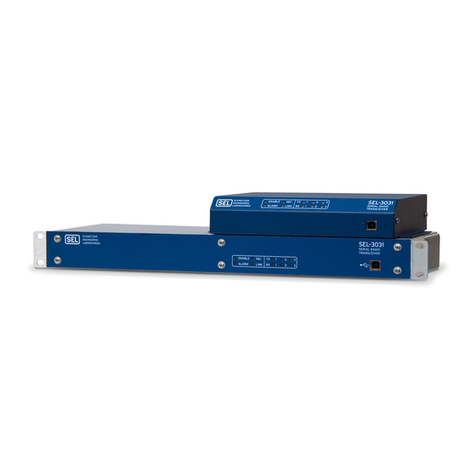
Schweitzer Engineering Laboratories
Schweitzer Engineering Laboratories SEL-3031 instruction manual
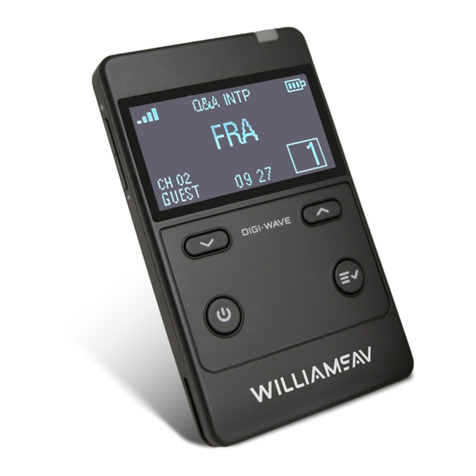
Williams AV
Williams AV Digi-Wave 400 Series user manual
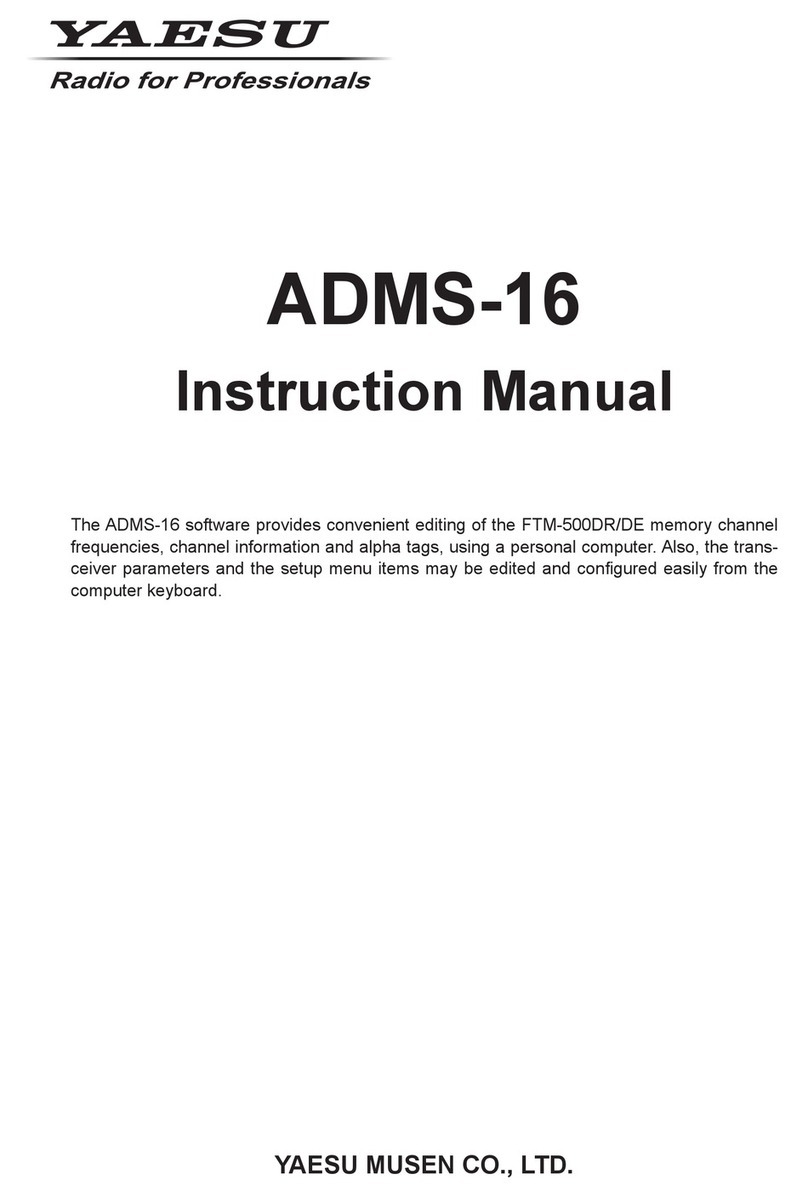
Yaesu
Yaesu ADMS-16 instruction manual
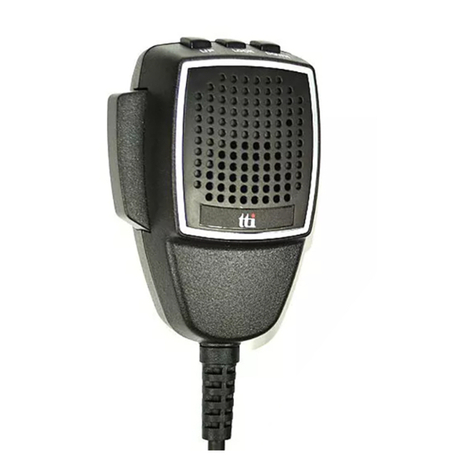
TTI
TTI Freequency TCB-770 instruction manual

SBE
SBE SB-34 Maintenance manual
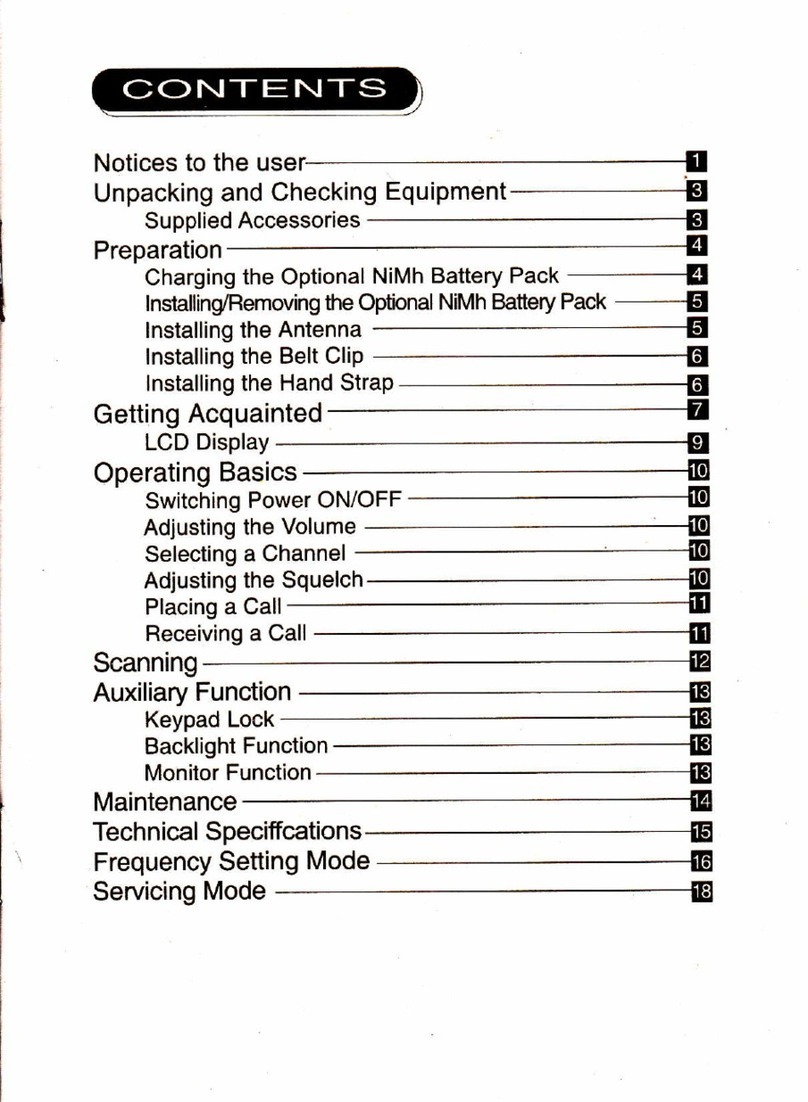
chinavasion
chinavasion CVSL-J71 user manual

